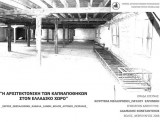Certain cities in Greece, such as Serres, Thessaloniki, Kavala, Ksanthi, Volos, Piraeus and Agrinio have in time developed to important tobacco centres, generating important building infrastructure for storing and processing tobacco. Many of these buildings, which are of particularly meticulous construction and architectural quality, still continue to dominate in central locations of the cities mentioned above. The subject of the present paper has been deliberately selected by the researchers since tobacco has been one of the most basic products that contributed significantly in the industrialization of the Greek state and helped Greek people to survive during very difficult and turbulent years.
Objective of this research paper is to highlight the most significant tobacco warehouses in Greece and investigate their architectural origin. The paper constitutes firstly an extensive bibliographic report on the history of tobacco, from the moment of its import in the country. At the same time, it is the product of the experiential on-the-spot study of the historical tobacco warehouses, carried out in the aforementioned cities from October 2006 until February 2008. The researchers have focused mainly on the pre-war warehouses, which display the greatest architectural interest. The paper concludes with the comparative study of the material collected and the formulation of some very interesting arguments.
To sum up, with the present research paper the researchers expected to inform about the remaining tobacco warehouses around the Greek territory and renew people’s lost interest in them.
